
Advertising Arts magazine from September 1933 celebrating Charles Coiner's National Recovery Administration logo.
Huey Long, the populist governor of Louisiana, purportedly said that if fascism comes to America it will be draped in the American flag and called Americanism. Unlike the rise of Italian Fascism and German National Socialism, what is described as American Fascism was not a “revolution” marked in its initial stages by paramilitary-led street violence. Despite the emergence in the 1930s of the “Fascist Shirts” (referring to the black- and brown-shirt rowdies in Italy and Germany and the Silver Shirts and White Hooded KKK in the U.S.), American Fascism was led by men in suits passing tough regulatory laws rather than wielding head-cracking leaden bludgeons. According to cultural historian Wolfgang Schivelbusch in his revealing book Three New Deals: Reflections on Roosevelt’s America, Mussolini’s Italy, and Hitler’s Germany, 1933 – 1939, the hero of American Liberalism, President Franklin Delano Roosevelt, actually had more in common with Europe’s Fascist leaders than not.
The New Deal, Roosevelt’s socio-economic program designed to extract the United States from the abyss of The Great Depression, was a rejection of classic, free-market liberalism in favor of a strong corporate state that stressed the importance of order, discipline, and planning. As early as 1912, FDR praised a Prussian-German concept of governance, stating “They passed beyond the liberty of the individual to do as he pleased with his own property and found it necessary to check this liberty for the benefit of the freedom of the whole people.” In 1934, the progressive writer Roger Shaw described the New Deal as “Fascist means to gain liberal ends.”
Fascism was not a dirty word or deed at the outset.
Fascism was not a dirty word or deed at the outset. FDR adviser Rexford Tugwell wrote that when Mussolini came to power in 1922 following the socio-economic devastation of World War I, he had done “many of the things which seem to me necessary.” Lorena Hickok, a close personal friend of the progressive humanist Eleanor Roosevelt said that if Roosevelt were actually a dictator, “we might get somewhere,” adding that if she were younger, she’d like to lead “the Fascist Movement in the United States.” The official Nazi newspaper, Volkischer Beobachter, praised “Roosevelt’s adoption of National Socialist strains of thought in his economic and social policies” and “the development toward an authoritarian state” based on the “demand that collective good be put before individual self-interest.”
Deplorable as it sounds, especially to all those who were raised in the glow of New Deal liberal progressivism, even in the 1930s political and media critics attacked Roosevelt and his National Recovery Administration (NRA), the governing agency of the early New Deal that sought to impose regulations on business and industry, as well as price and wage controls, decrying “The Fascist Principles [in Europe] are very similar to those we have been evolving here in America.”

Propaganda for FDR’s program was relentless. The government bombarded Americans with demands to join the NRA and ostracized those who refused to participate. In what Schivelbusch called a “war of symbols” the NRA logo, the “Blue Eagle”, presumably sketched by Hugh S. Johnson, NRA Director, and designed by AIGA Medalist Charles Coiner (who was celebrated for his design in Advertising Arts magazine), a blue spread winged eagle holding lightning bolts in one claw and a gear in another, echoed the Fascist and National Socialist symbols of the era. It was conspicuously used in the United States by businesses to show compliance with the NRA whose modus operandi the Supreme Court later declared unconstitutional. Its motto “We Do Our Part” sounds innocent enough, but Schivelbusch argues it was code for businesses to avoid being targets of sanctioned boycotts (code because it was illegal for the government to order a boycott).
Graphic design was integral to these social-political interventions. The NRA, Fascist, and Nazi brands, while visually distinct, nonetheless had both strategic and aesthetic similarities. They served the same purpose too: engage citizens and exclude the opposition. Displaying signs and flags or wearing badges and buttons meant one was either for or against. Nonetheless, in the U.S. dissent was tolerated to a point, in Germany and Italy heaven help you. But the underlying message was conformity, or else.
